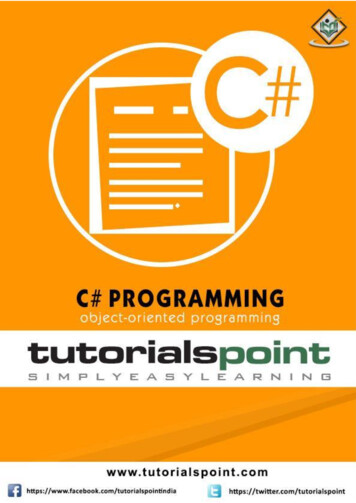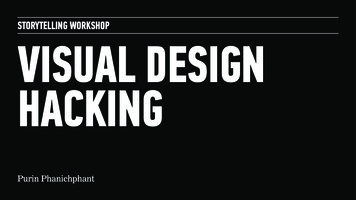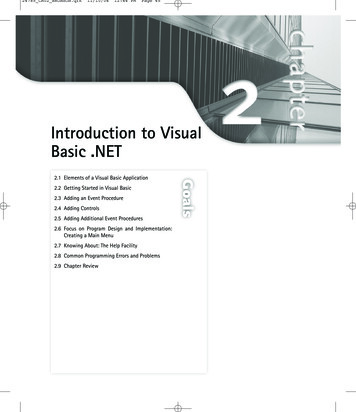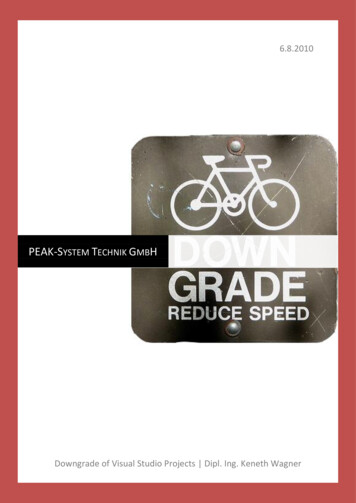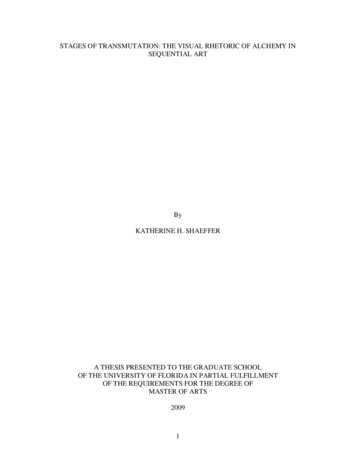
Transcription
STAGES OF TRANSMUTATION: THE VISUAL RHETORIC OF ALCHEMY INSEQUENTIAL ARTByKATHERINE H. SHAEFFERA THESIS PRESENTED TO THE GRADUATE SCHOOLOF THE UNIVERSITY OF FLORIDA IN PARTIAL FULFILLMENTOF THE REQUIREMENTS FOR THE DEGREE OFMASTER OF ARTS20091
2009 Katherine Shaeffer2
To my family, both by blood and of the heart3
ACKNOWLEDGMENTSI thank the members of my thesis committee, Dr. Paxson and Dr. Ault, for believing inthis project. I thank my parents, James and Suzie Shaeffer, for all of their support. I also extendmy thanks to Sean, Laurel, Terry, Steff, Claire, James and David, for friendship, and to NicholasFlammel, for starting a trend.4
TABLE OF CONTENTSpageACKNOWLEDGMENTS. 4LIST OF FIGURES . 6ABSTRACT . 7CHAPTER1INTRODUCTION. 82AN OVERVIEW OF ALCHEMY . 163ALCHEMICAL PICTURE SEQUENCES, MEDIEVAL AND EARLY MODERN . 26Illustration in The Works of Geber (illustrations 1545; original text 7th Century). 32Nicholas Flammel's Book of Hieroglyphics . 34The Donum Dei (15th century; illustrations 17th century). 37The Mute Book (1677; colored late 18th century). 39The Elementa chemicae Illustrations (1718) . 41The Visual Rhetoric of the Alchemical Picture Sequences . 424ALCHEMY IN COMICS / ALCHEMY IN ACTION . 47Epileptic . 47Fullmetal Alchemist . 49The Metamorphae: Metamorpho and Element Girl . 51Element Girl (Urania Blackwell) . 51Metamorpho: The Element Man (Rex Mason) . 56Alchemy (Thomas Jones) . 58Promethea . 60John Constantine, Hellblazer: Dangerous Habits . 62The Function of Alchemy in Comics . 665CONCLUSION . 77LIST OF REFERENCES . 80BIOGRAPHICAL SKETCH . 845
LIST OF FIGURESpageFigure3-1Donum Dei: stages of whitening and reddening (Roob 358) . 443-2The Mute Book, Plate 5 (Roob 304) . 453-3Elementa chemicae illustration: "the lapis attains its fiery nature"(Roob 114). 464-1Edward makes gold in Fullmetal Alchemist (Arakawa 129) . 684-2The Elric laboratory in Fullmetal Alchemist (Arakawa 63) . 694-3Sandman: Dream Country: Urania makes herself up in "Façade" (Gaiman 8) . 704-4Sandman: Dream Country: Urania makes herself "nitrogen"(Gaiman 13) . 714-5Rex Mason transforms in Metamorpho: Year One (Jurgens) . 724-6"Or gold. Haven't I done gold?" (Simonson 3) . 734-7A transformation to a cadaceus in Alan Moore's Promethea (Moore) . 744-8Magic stout in John Constantine, Hellblazer: Dangerous Habits (Ennis 43) . 754-9The devil as alchemical vessel in John Constantine, Hellblazer: Dangerous Habits(53) . 766
Abstract of Dissertation Presented to the Graduate Schoolof the University of Florida in Partial Fulfillment of theRequirements for the Degree of Doctor of PhilosophySTAGES OF TRANSMUTATION: THE VISUAL RHETORIC OF ALCHEMY INSEQUENTIAL ARTByKatherine H. ShaefferMay 2009Chair: James PaxsonMajor: EnglishThis project examines artistic and literary presentations of alchemical transmutation inthe Medieval and Early Modern periods, along with appropriations of alchemical ideas andimagery in present day comic books. It looks at the relationship of the verbal and visualdepictions of alchemy with the conceptualization of alchemy as a process which occurs in time.The focus of this project is on material alchemical transmutation, rather than the allegorical andspiritual elements with which examinations of alchemical writing and art have generallyconsidered most central. Within this body of literature, very little has been written on thepresentations of the physical change of matter in alchemical image sequences.The project is limited in its examination of alchemical change in the modern day to itspresentation in comic books, even though there is certainly room for study of recent prosefiction, most particularly in the fantasy and science fiction genres, that utilizes alchemical ideas.Rather than tackling the full body of alchemy-related literature, this project directs the reader tofurther resources in these fields in Chapter Two.The sequences of static images found in both early artistic representations of alchemy andcomic book appropriations of alchemy offer unique, yet related ways of looking at time, spaceand change.7
CHAPTER 1INTRODUCTIONOne could make the claim, without too much fear of error or correction, that alchemicalliterature breaks down readily into three categories: alchemical allegory, alchemical satire anddepictions of literal alchemy. Early alchemical writings of the Middle Ages generallycompounded the allegorical with the literal, describing processes of transmutation at the sametime that those very processes and their material components were personified and allegorized bysymbolic figures which tied the mundane, practical meaning of the texts to larger claims aboutthe spirit of man (specifically, the alchemist himself) and the workings of the universe.According to many scholars of the alchemical writings of the period, the allegorization oftransmutation also functioned as a code that would keep the philosopher's secrets shrouded inmystery, and conveniently obfuscate those places where the alchemical theories described failedto work when practically applied. Alchemical satire maintains alchemy as a physical, literalpractice, but that practice is one of failed experiments and charlatanry. These alchemical fraudsand failures crop up in not only anti-alchemical treatises banning the 'art,' but fictions like BenJonson's The Alchemist and Chaucer's Canon's Yeoman's Tale. Even in alchemical satire,however, alchemy, howsoever fraudulent, can lead to real change, not within but without thealchemical vessel: Subtle's deceit in Jonson's comic play leads to real social change (andeventually to a real marriage); the experiments of both canons in the Yeoman's Tale performwhat I term a kind of anti-alchemy 1 upon themselves and the people and world surroundingthem, systematically degrading, destroying and tarnishing, rather than improving and purifying.1I argue that the alchemical procedures described in the Canon's Yeoman's Tale constitute an anti-alchemy thatinverts the ideologies and processes of ideal alchemical transmutation, as well as simply subverting the desiredresult. The canon's alchemy is in direct and aggressive opposition to all that either spiritual or material alchemyshould be, but as such it does still succeed in bringing about change.8
More recent studies of alchemy's presence in fiction and poetry also tend to focus on theallegorical, examining works like the Chymical Wedding and narrowing in on transformativethemes and metallurgic references in Yeats and many other nineteenth and twentieth-centurywriters.Even the more pragmatic alchemical texts are commonly read allegorically, still seen ascode for the soul's transformation even once gods and phoenixes are (literally) not in the picture.There is a long-standing tradition of saving early alchemical writings from themselves byclaiming that their true goal was the guidance of the self towards a state of perfection, and notthe production of silver or gold. The removal of the alchemical 'taint' from the work of Sir IsaacNewton is only one of many examples. While in many cases this message of salvation may notbe incorrect, something very important is lost when the physicality of metamorphosis is removedfrom the study of alchemical writing, the same way something is lost when allegory itself, ifalchemical writing must be read allegorically, is treated only as a veil to be lifted and then castaside.Gordon Teskey, in his interrogation of the Faerie Queene in Allegory and Violence, refersto "the truth over which allegory is always drawing its veil: the fundamental disorder out ofwhich the illusion of order is raised" (19). Teskey points toward the "sin" of Francesca as "a sinagainst allegory," and that sin is "to show that there are some things in life that cannot becaptured by books" (20). The 'capturing' of things into books (or language, in the broader sense)is allegory, and thus all literature is painted as ultimately allegorical, capable of being read andimbued with deeper meaning.When one comes right down to it, everything can be alchemy because nothing escapeschange, and all language and thought can be allegory because no word or concept is exactly the9
thing that it signifies, but that does not mean that it becomes fruitful to apply either alchemy orallegory to everything.C. S. Lewis, in his Allegory of Love, argues that allegory belongs "to man . . . or even tomind, in general" (44), and that man has always and inevitably been a producer of allegory. Inthe same chapter, Lewis puts forth "another way of using the equivalence [of passions andvisibilia]," which he terms sacramentalism or symbolism, used in the allegorization of aninvisible world by the material world:It is, in fine, 'in the philosophy of Hermes that this visible world is but a picture of theinvisible, wherein, as in a portrait, things are not truly but in equivocal shapes, as theycounterfeit some real substance in that invisible fabrick.' (45)The "sacramentalism" that Lewis describes is deeply entwined with the roots of alchemicalthought; in the Asclepius of Hermes Trismegistus, "the forms of all beings conform to theirarchetypes so that the archetype is a whole; the individual is a part of the archetype" (Salaman56) and just as "what is good or happy has always been high like the heavens and bright like thesun" (Lewis 44), in the Asclepius the "Sun is a second god. . . . As the cosmos is everlasting, sothe Sun is the everlasting ruler of all things that live and of their very life force; it gives forth lifeand does so continually" (85). This simultaneous conjunction and disjunction of the spiritualwith the ('real') material in alchemical allegory is key to the seventeenth-century split that Jungdescribes between "the chemist and the Hermetic philosopher" in (Psychology and Alchemy227). In the Western tradition, very few writings exist on 'pure,' literal transmutation, untouchedby either allegorical references or allegorical revision; and when such writings do occur, they areby and large considered undesirable in the alchemical canon, ridiculed in art and academia bothcontemporary and modern for their shortsightedness, the alchemists themselves depicted aseither greedy frauds or futilely struggling fools.One exception to this general rule may be the presentation of successful Philosophers in10
what functioned as alchemical handbooks, in which the genius alchemsits' works were eitherconveniently located in the distant past or described in such vague or convoluted terms that theexperiments are not reproducible. At the same time, many instructional treatises on alchemywere heavily allegorized, and when they were not, their lack of detail occasionally allowed foronly incomplete depictions of the transmutations described therein.The tradition of academic distaste for, and universal distrust of, material alchemicaltransmutation leads to a deceptively simple conclusion: it is not "grown up" to talk aboutalchemical transmutation without either an allegorical or satirical component.One of the challenging aspects of both alchemical study and the study of alchemicalwriting is that alchemical transmutation (reduced to its most basic components) is ultimatelychange. Slowly yet surely, alchemy in literary studies becomes shorthand for changing andcreating: writing itself, personal redemption and character development all become alchemy.Alchemy can be applied to all forms of creative expression, and as evocative as the word is inthese contexts, its overextension divorces it from more concrete meanings, and it is the concretein alchemy that most interests me in this project.The reasons behind the narrowing of the focus of this project to material alchemicaltransmutation are threefold. The first is a simple matter of pragmatism, for to sufficiently coverall aspects of figurative alchemy would open up any and all forms of creator-controlled changeto examination, and such an endeavor is far beyond the scope of the project at hand; the secondis a matter of preference: in recent study, symbolic alchemy has been by far the favored child,thus leaving material transmutation open to innovative investigation; and the third and mostimportant reason is that material alchemy opens up opportunities for the study of visualrepresentations of physical change.11
This project begins in Chapter Two with a general overview of the alchemical conceptsthat will be used to understand the visual rhetoric of transmutation in later chapters, as well as abrief discussion of depictions of alchemical transmutation in literature. Chapter Three goes on toexamine visual presentations of transmutation in sequential pictorial alchemy, while ChapterFour continues the focus on transmutation in sequential images through its look at alchemy incomic books. Alchemical picture sequences and comics have been selected as the cornerstones ofthis project, rather than other visual/textual media representations of alchemy, because they shareboth a genuine investment in the visual presentation of temporal progression and similarnarrative frameworks. 2The depictions of alchemical transmutations on the page take several forms, but the mostnotable distinguishing qualities of their different modes of presentation are the speed of thetransformation, the kind of time utilized in the transformation (e.g. linear versus cyclical) andwhether the alchemical power is natural or learned.The tradition of alchemical illustration is also, in most cases, heavily invested in theportrayal of the alchemist himself (and on rare occasions herself), as well as of his laboratory andequipment. The noteworthy qualities of illustrations of the alchemist include props, the presenceor absence of other figures, the surrounding environs and the actions performed. There has beena move in recent years, at least in the comics that take up a significant portion of this study, totransform the solitary student/alchemist of legend, hunched over his alembic or book, into apresent-day action hero, supplanting the vita contemplativa of the classic alchemist with the vitaactiva.2While alchemical transmutation in children's picture books would, based upon these same criteria, also beappropriate to this study, I will not be focusing on them for the simple fact that I have not yet seen enough suchexamples to make sufficiently informed conclusions about the function of alchemy in that medium.12
Though the 'big names' of alchemy are frequently invoked in early alchemical writing,the alchemists visually presented performing transmutations and distillations are more indistinct:the actual figures embody, instead of incarnations of specific men and women, the ideals andstereotypes that constitute the idea of the 'alchemist.' In the alchemical picture sequencesexamined in Chapter Three, this may be largely due to the instructional and exemplary nature ofthese texts; as the reader, potentially, may wish to perform his own versions of the alchemicalexperiments presented, the alchemists presented must represent attainable ideals rather thanspecific, recognizable persons.Change in physical matter is dependent upon time and space, and this project'sexamination of the spatial and temporal relations of objects, as presented verbally and visually inthe texts under scrutinization, pulls largely from the theoretical physics of Aristotle, as well as itslater theoretical incarnations. In its discussion of visual representations of space and time on thepage, this project also owes a debt to Mary C. Olson's Fair and Varied Forms: Visual Textualityin Medieval Illuminated Manuscripts, in which Olson expounds upon "Narrative Time inGraphic Space" in a chapter of the same name.In my investigation of both the alchemical picture narratives of the Early Modern periodand comic narratives of the late twentieth and early twenty-first centuries, my structural andvisual focus will be on the design, transition, placement and general use of the panel.Thierry Groensteen, in his System of Comics, chooses to use the panel as his "reference unit" preciselybecause the panel is, for his, in some senses irreducible: In its habitual configuration, the panel is presented as aportion of space isolated by blank spaces and enclosed by a frame that ensures its integrity. Thus, whatever itscontents (iconic, plastic, verbal) and the complexi ty that it eventually shows, the panel is an entity that leads togeneral manipulations. One can take it, for example, in order to enlarge it and create a seriagraph; one can also moveit. (25)13
Groensteen evokes in this quote the very modern, very Western, comic page, influencedby a visible grid or framework and comprised of clearly defined panels framed individually andseparated by "blank spaces." This design is what functions as the generic default of the Americancomics "mainstream," 3 but it is of course not representative of the way in which all comcis areassembled, and is furthermore misleading when discussing the panel within alchemical picturesequences. Groensteen's most significant qualification of the panel, for my purposes, is that it "iseasily contained by and takes part in the sequential continuum" (26). In comics that representtime (and comics do almost by definition in one way or another; there may, however, be someexperimental "comics" that avoid manage to resist presenting time), a panel embodies a completeidea, moment or sequence of an existence in or action through time. At their simplest level, whatcomics present is space and time: space and the objects 'in' it through pictures and time throughthe indication of actions, thoughts and events both in the organization of those pictures (panels)and their content, both pictorial and verbal. Panels are the discrete units of of thatspatial/temporal structure.The 'panels' of the alchemical picture sequences that I examine in Chapter Three may notall follow modern comic conventions (with a grid layout, black frames, and gutters betweenpanels) but they do evoke frameworks, and even without frames and gutters serving as guidelinesfor the eye, the division of these texts into distinct temporal units (designating moments in orperiods of time separate/d from other time) is clear. The Mute Book, for one, certainly has morein common structurally with the "mainstream" comic book than does, for example, the Bayeuxtapestry, which makes its way as a 'proto-comic' into nearly every instructional or academic text3In both academic and lay discussions of comics, the term "maintsream" has come to refer to narratives revolvingaround the superhero and action hero.14
on comics as a matter of course. 4 These concepts will be discussed in more detail in ChaptersThree and Four.4The popularity of this move has reached a point where the incorporation of this artifact in instructional texts andlectures on comics has become a bit of a joke within comics scholarship; Matt Madden's reference to the tapestry inhis 99 Ways to Tell a Story is, while still technically in this tradition, quite noticeably tongue-in-cheek.15
CHAPTER 2AN OVERVIEW OF ALCHEMYIf the Vertues of this never-sufficiently praised Metal, were known, as well for the health ofthe Body, as the convenience of mens living, it would be adored with a greater devotionthan it is already. The Apes of Wise Nature, cunning Inquirers in Experiments, perceivinga certain Glory and Brightness in Gold, and an attractive or magnetick vertue (if I may sosay) which at first sight draws every mans eye to look upon its Majesty and Beauty, andtempts our hands to touch and handle it, and even our mindes to desire it, so that evenInfants do rejoyce, and laugh at the sight of it, and reach their arms out after it, and catchit, and will by no means part from it; presently conjectured, that there was someextraordinary Vertue in it for the health of man.--Giambattista della Porta on Gold, Natural Magic, 271In the 1970 Ambix article, "Alchemy: Origin or Origins?" H.J. Sheppard offers as adefinition for alchemy (in its broadest sense, and not limited to a European understanding ofalchemy) as "the art of conversion of that which is base, both in the material and spritual worlds"(Debus 79-80). More recently, Sheppard has offered another definition for alchemy as "the art ofliberating parts of the cosmos from temporal existence and achieving perfection which, formetals is gold, and for man, longevity, then immortality and, finally, redemption" (Linden 11).According to Sheppard, alchemists thought of themselves as not only remaking materials, but aschanging the temporal duration of ultimately natural processes. In the transmutation of metals,this meant that the natural, linear progression of baser metals into pure gold was shortened; inphysical human development, this meant that the natural lifespan of a human being waslengthened (11).Medieval and Renaissance students of alchemy in the Western tradition, by and large,held a common picture of the workings of the material world, and this common viewincorporated the theory of the four elements (generally associated with Aristotle, though itappears in the works of earlier philosophers--like Empedocles--to some of whose ideas Aristotle16
openly subscribed) and their properties; Geber's theory of the importance of sulphur and mercuryin the creation of metals; the existence of a prima materia that was the ultimate and universalsubstance from which all matter was composed (thus permitting the transformation of matterfrom one thing or state to another); and the associations of metals with the sun, moon andplanets.Any brief overview of literature on alchemy will reveal that the Western alchemicalbeliefs and principles on transmutation ultimately derive from the theories on mineralogy as putforth by Aristotle. In Aristotle's "philosophy of nature," all matter is made up of the fourelements earth, water, air and fire, each of which exhibits two of the significant and contradictingqualities of hotness, dryness, wetness and moistness:The elements are four, and any four terms can be combined in six couples. Contraries,however, refuse to be coupled; for it is impossible for the same thing to be hot and cold, ormoist and dry. Hence it is evident that the coupling of the elements will be four: hot withdry and moist with hot, and again cold with dry and cold with moist. And these fourcouples have attached themselves to the apparently simple bodies (Fire, Air, Water, andEarth) in a manner consonant with theory. For Fire is hot and dry, whereas Air is hot andmoist (Air being a sort of vapour); and water is cold and moist, while Earth is cold and dry.(Aristotle, On Generation and Corruption, II.3, lines 30-35)Medieval and Renaissance alchemy also generally accepted and integrated Aristotle'sexplanation of the development of minerals, which he averred are formed in the earth due to theinfluence of two distinct "exhalations":We maintain that there are two exhalations, one vaporous and the other smoky, and therecorrespond two kinds of bodies that originate in the earth, things quarried and thingsmined. The heat of the dry exhalation is the cause of all things quarried. Such are the kindsof stones that cannot be melted, and realgar, and ochre and ruddle, and sulphur, and theother things of that kind, most things quarried being either coloured lye or, like cinnabar, astone compounded of it. The vaporous exhalation is the cause of all things mined--thingswhich are either fusible or malleable such as iron, copper, gold. All these originate fromthe imprisonment of the vaporous exhalation in the earth, and especially in stones. Theirdryness compresses it, and it congeals just as dew or hoar-frost does when it has beenseparated off, though in the present case the metals are generated before the separationoccurs. Hence, they are water in a sense and in a sense not. Their matter was that which17
might have become water, but it can no longer do so; nor are they, like savours, due to aqualitative change in actual water. Copper and gold are not formed like that, but in everycase the evaporation congealed before water was formed. Hence, they all (except gold) areaffected by fire, and they possess an admixture of earth, for they still contain the dryexhalation. (Aristotle, Meteorology, III.6, lines 19-34)The combination of the four-elements theory with the idea of all minerals resulting from thecombination of two primary forms of matter reappears consistently in alchemy in the Westerntradition, though Aristotle's depiction of smoky and vaporous "exhalations" is not repeated sooften as the sulphur-mercury theory attributed to Geber.Jabír ibn Hayyan, or Geber (an alternate spelling used for Jabír), accepted Aristotle'smineral theory in general, but modified it by adding an "intermediate conversion":The two exhalations, he believed, when imprisoned in the bowels of the earth, were notimmediately changed into minerals or metals, but underwent an intermediate conversion.The dry or smoky exhalation was converted into sulphur and the watery one into mercury,and it was only by the subsequent combination of sulphur and mercury that metals wereformed. The reason of the existence of different varieties of metals is that the sulphur andmercury are not always pure and that they do not always combine in the same proportion.If they are perfectly pure and if, also, they combine in the most complete naturalequilibrium, then the product is the most perfect of metals, namely gold. (Holmyard,Works of Geber, xii)It is Geber's version of Aristotle's mineral theory that "survive[s], with some alterations andadditions, until the beginnings of modern chemistry in the eighteenth century" (Holmyard, Worksof Geber, xii). The focus on mercury and sulphur remained prominent throughout the EarlyModern period, as did Geber's claim that the sulphur and mercury actually used in the creation ofother metals were not "the well-known substances which go by these names, but hypotheticalsubstances to which ordinary sulphur and mercury form the closest available approximations"(Holmyard, Works of Geber, xii).These elements, their constituents and their properties are repeated subjects foralchemical imagery, and frequently appear in the form of a graph which places the four elementsor four properties at oppositions to one another. These graphs then indicate the associations18
between the properties and elements, often incorporating the (bodily) humours connected to theproperties of wetness, dryness, hotness and coldness. Alchemical literature is built upon theinteraction of oppositional forces and concepts. Especially popular in recent discussions of thesubject is the division set up between exoteric (or external) alchemy and esoteric (or internal orspiritual) alchemy.Exoteric alchemy describes the quest to transmute objects in the material world, and ismost frequently understood in terms of the practicing alchemists' attempts to create eitherprecious metals (most particularly gold) or the Philosopher's Stone itself, which would in turn beused in the transformations of base metals into purer forms. Exoteric alchemy is the side ofalchemy that has been most criticized, both by
captured by books" (20). The 'capturing' of things into books (or language, in the broader sense) is allegory, and thus all literature is painted as ultimately allegorical, capable of being read and imbued with deeper meaning. When one comes right down





